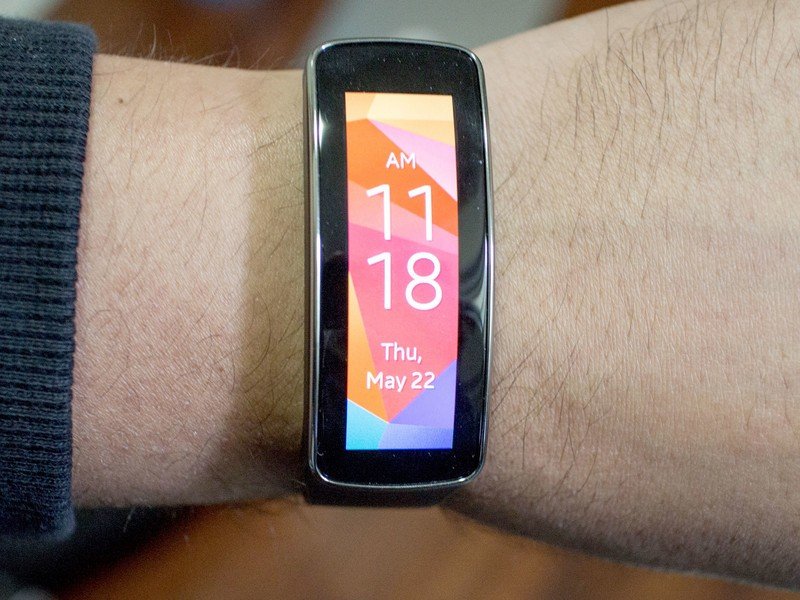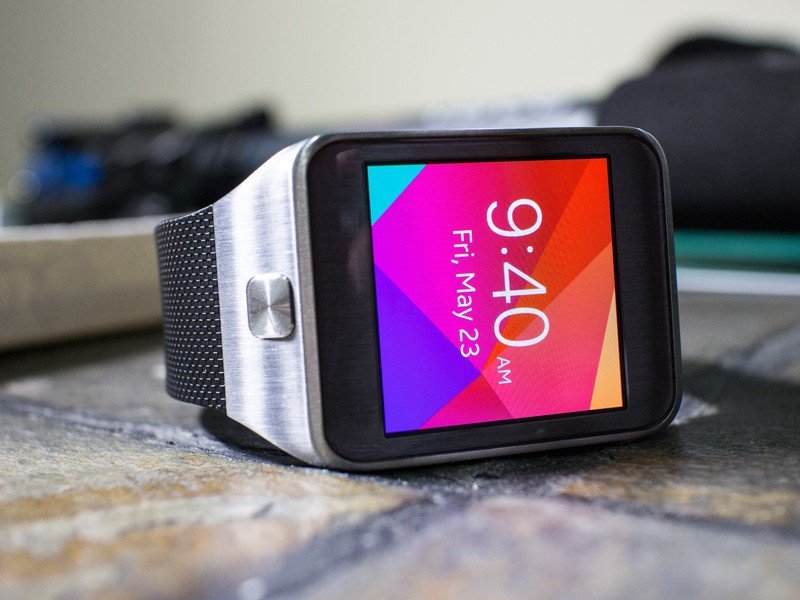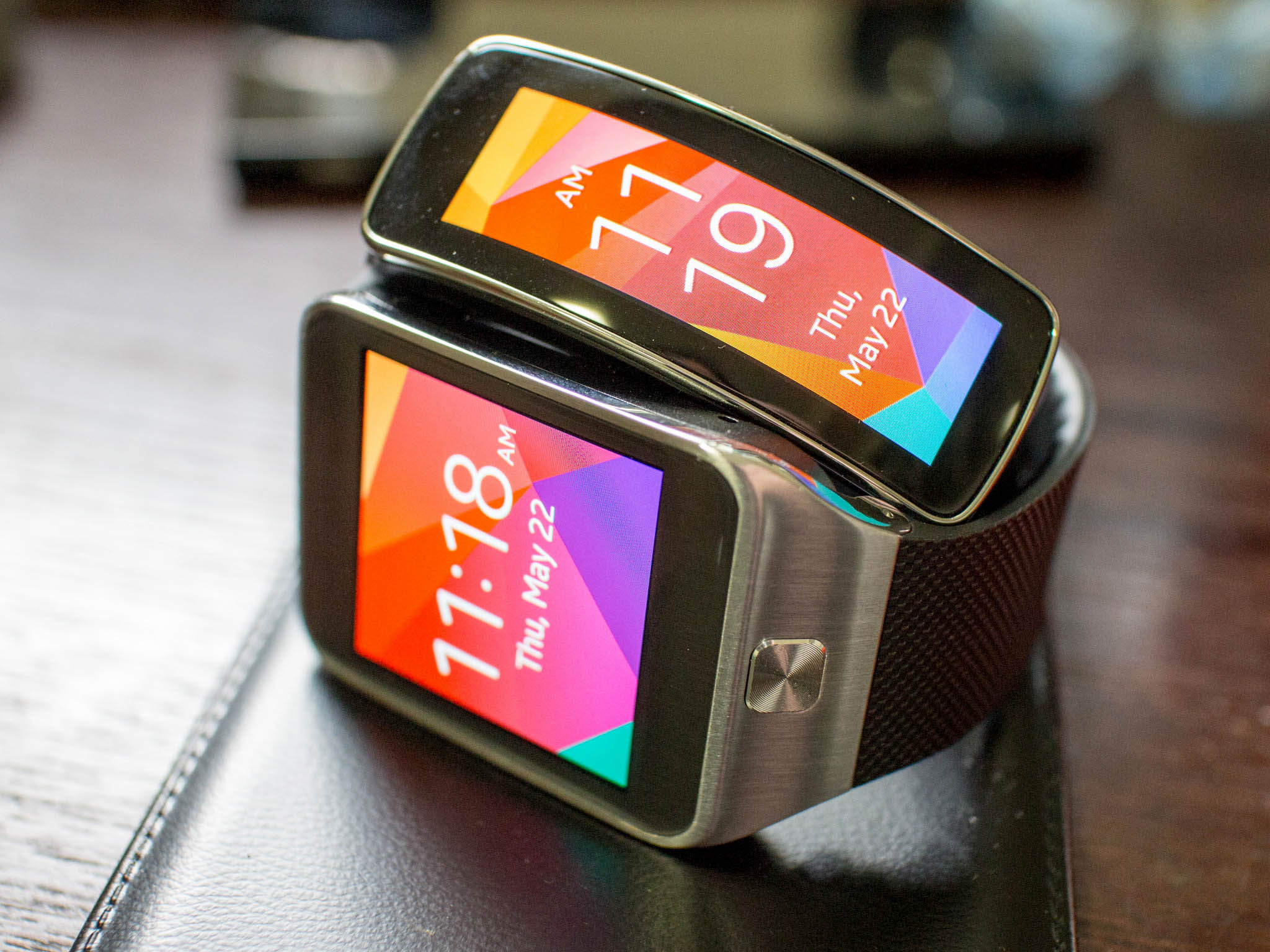The new Samsung Gears
The Samsung Gear 2, Gear 2 Neo and Gear Fit are the next-generation wearables from Samsung, following up on the popular Galaxy Gear smartwatch.
There are three new devices, but we really can break them down into two categories, all with the same things going on deep inside. The Gear 2 and Gear 2 Neo are really the same watch, only the Neo has no camera — and it costs $100 less than the Gear 2. The Gear Fit does mostly the same stuff as the other two, only it lacks a few of the advanced features, has a different form factor, and it's the same price as the Gear 2 Neo. Lost yet?

When the Galaxy Gear was first released, it was a "revolutionary" device that didn't have much competition at the time. Even though it only worked with Samsung's own phones, it was still a hot seller and widely adopted by many smartwatch users. Now, as we move forward and have Android Wear-based watches like the Moto 360 and LG's G Watch on the horizon, it's hard to say how long the new Tizen-powered Gear devices will remain atop current smartwatch market. They are some good new offerings from Samsung, but with Android Wear on the way, they could soon be outdated. They aren't the most full-featured devices, but they still look good and work well, providing you've got a Samsung phone to use them with.
The new Gear line is definitely a step above the previous generation, but it may still not be enough to make them the best choice of smartwatch. Read on to see how it all breaks down.

Gear 2 and Gear 2 Neo hardware
Looks good, feels good
Gear 2 and Gear 2 Neo
The Gear 2 is actually a really nice looking piece of hardware. I can see myself wearing it casually or even as a "dress-up watch," something I strayed away from with the Galaxy Gear. One of the issues with something like the Pebble is that it's not the most stylish device there is (hence the need for a Pebble Steel) but with the Gear 2, you can wear it in pretty much any situation and still pull it off — even more so now that you can change the band. The brushed metal front isn't too far away from the original Galaxy Gear, but the face has been smoothed out a bit and those industrial-looking screws are no more.
You can wear the Gear 2 in pretty much any situation and still pull it off — even more so now that you can change the band.
The Gear 2 still looks like its older brother, but it has been slimmed down and revamped just enough to make it a little bit better. You'll notice right off the bat that the power button has been moved to a flush-mount style on the front of the watch face, rather than the side. The other glaring difference is that the camera wart that was protruding from the band is now gone — the camera has been moved onto the watch face as well — though it's much less noticeable than before.

The design isn't that far off from the previous generation, but it's still just enough to make me like the Gear 2 that much more. The Gear 2 is IP67 certified, meaning you can get it wet or rough it up with little worry, though I wouldn't go swimming with it on. It's sporting a 1.6-inch display with a 320x320 pixel resolution. The camera also gets a minimal upgrade from 1.6 megapixels to an even 2MP. Inside there is a 1.0 GHz dual-core processor, Bluetooth, 4 gigabytes of storage, 512MB of RAM, and a 300mAh battery (which got us around two to three days of solid use on a charge).

I had big issues with wearing the original galaxy Gear. The band was big and clunky and just all around uncomfortable for me. I couldn't wear it for more than an hour or two without having a burning desire (need actually) to take it off. Thankfully with the Gear 2 that feeling is no more. It feels like a real watch and is plenty comfortable to wear through the day. It's also a bit thinner and just enough so that it won't snag on your shirt sleeve, as the previous generation did all too often.
I had big issues with wearing the original galaxy Gear. Thankfully, the Gear 2 feels like a real watch and is plenty comfortable to wear through the day.
It does come in a variety of colors, only now you're not constrained to just one, bulky, uncomfortable band. The stock band feels great for the most part, but you can choose any number of standard 22mm watch bands as a replacement since there's no camera or microphone built into the strap. Definitely a bonus.
One thing I did have a problem with was the clasp on the stock band. Rather than just snapping in to lock in place, you have to do a little upward push motion to get it to hook in correctly. Not a huge deal after you get used to it, but annoying enough for the time I used the watch.
Gear Fit

The Gear Fit I actually like quite a bit, and it's been the bigger talker since its announcement at MWC. It's comfortable to wear and though it doesn't really have that "watch" look, I still feel comfortable wearing it out. It's obviously more of a beefed-up fitness band than a straight-up smartwatch, so it may not be for the more fashion conscious. If you're looking to go the watch route you'll want to stick with the Gear 2 or Gear 2 Neo, but for those aiming more toward the health tracking, this is the way to go. The Gear Fit does fit my wrist well though and I really had no problems wearing it. It also has a changeable strap should the standard black one not suit you.
The Gear Fit is more a beefed-up fitness band than a smartwatch.
The Gear Fit is outfitted with a curved 1.83-inch 432x128 Super AMOLED display. At the heart is a 210mAH battery to keep it going for three to four days on average. The Fit is also super light — it's just 27g compared to the 68g of the Gear 2 and 55g of the Neo since it's lacking a camera).


For all of the devices you can also change up the clock face and wallpaper, either with the built-in faces or add-ons from the Samsung apps store (though the selection is still fairly slim). This adds a lot to the device as you're not limited to just one style of face, and you can choose what fits you best — be it digital, analog or even weather.
I like that the heart-rate sensor is built-in, I just wish it worked a bit better.
On the back of all three watches you'll find the charging connectors (more on that below) and the heart-rate sensor. The heart-rate sensor was a bit hit or miss for me, but when it worked it was fairly accurate. I did use it a few times before I took off the protective plastic (rookie mistake) but it did a bit better once that was removed. I do like that it's built in and you don't need a separate accessory, I just wish it worked a bit better and more of the time.

One of the big cons for me is the annoying charging adapter for the Gear 2 and Gear Fit (both different as luck would have it). I can't even say if I hate them more or less than the Galaxy Gear "cradle" so I'll just say they're still annoying. This time around the chargers come in the form of a small clip that attaches to the band and takes a micro USB. They work as they should and hold onto the watch well when charging, but I really don't want to have even more little adapters that I need just so I can charge my watch. I'm sure it won't be a big issue for everyone, but I have more proprietary chargers than I can count at this point. Not the worst design ever, but it's yet another charger that I have to carry around with me.

Gear 2 and Gear 2 Neo software
It's Tizen and not Android, but does it really matter?
The Gear 2, Gear 2 Neo and Gear Fit all run on Tizen, not Android. This really doesn't matter at all since there's no way to tell the difference, and it doesn't change anything in the long run. You still connect the watch to your Samsung phone over Bluetooth, and you still use the same Gear Manager app on that phone to do so. The Gear Manager app still isn't the greatest, but it's the only connection between your Gear and the outside world. You can tweak mostly all of the settings from within the phone app, which is much easier than actually doing the same on the watch.
The new Gear smartwatches all run on Tizen, not Android. This really doesn't matter at all in the end — you can't tell a difference.
For the Gear 2 and Gear 2 Neo, everything you'd expect to be there is there — clock, gallery app, camera, settings, phone dialer, contacts app, calendar, pedometer, sleep tracker, heart-rate monitor and exercise tracker. The Gear Fit has most of the same, though it lacks the on-board music player as well at the camera and phone apps. Navigating around is as easy as swiping where you want to go and tapping the big, bright icons. Swipe down from the top bezel to go back. Most of the apps are easy to figure out and use, so there shouldn't be too much of a learning curve for most people.
Mixed in with the set of native apps on the Gear 2 are some cooler ones like the WatchON remote and built-in music player that lets you rock out even without a connected phone. Others are most utility type (stopwatch, alarm) or the health set that includes S-Health, the pedometer and heart-rate sensor.

As far as notifications go, they are much improved over the Galaxy Gear. They still require a lot of tapping and swiping, but they are more reliable and support more apps. Previously you were limited to many of the notifications that came to the watch, but now you have much more to choose from within the Gear Manager. New ones will pop up as they come in, and you can change up the style of notification a bit if you'd like. You can also view a history of notifications, sorted by app, and delete them all at once.
Phone calls can be answered from your watch by using the slider when a call comes in. Green to answer, red to ignore. If you decline a call, you also have the option to send a text message using a list of presets.


Perhaps one of the best new features is the built-in music player of the Gear 2, allowing you to transfer and store music on the actual watch, rather than just stream it from your phone. Granted, storage space is limited, but you can still sneak enough on there for a few hours when you don't have your phone handy. You can store tracks and play them back over Bluetooth, so if you're out running or just don't want to use your phone, your music is there for the taking — even if it's only around 4GB worth.
The camera is nice to have on the Gear 2, but it's still not something I need on a smartwatch. I'm sure there are a bunch of users that embrace the idea of a camera on their watch, but for me, it's just an extra $100 that I don't need to spend when the Gear 2 Neo does everything the same.

Samsung Gear 2 and Gear 2 Neo: The Bottom Line
Great second effort, but still not the best
- The new Gear devices all have great hardware that's well designed and stylish. They also offer many features that users will love like an on-board music player (Gear 2) and built-in heart rate sensor.
- A big downside is that these still only work with Samsung devices. They are also still a bit pricey compared to other watches with similar features, and have charging adapters that are annoying to use and could easily be lost.
- Overall I like the new Gear devices, but I have a hard time recommending them. Many don't own Samsung a phone and thus won't be able to use these at all. Even those that do, I'm not sure they're the best option right now. There's the less expensive Pebble, plus Android Wear devices are on the way. So while the new Gears are a great second offering from Samsung, I'd skip them for now and hold out to see what comes down the road.
When it comes down to it, the Gear 2, Gear 2 Neo and Gear Fit are all nice devices, but not necessarily worth buying at this point in time. The Gear 2 Neo and Gear Fit are the same price, with the camera add-on for the Gear 2 running another $100 — all a bit pricey. If you're a Samsung phone owner and simply need to have one — then go for it. I'm sure you'll be good with it and not have too many regrets, but with Android Wear on the way and the smartwatch game ramping up like never before, it's tough to say that these are really the best options for right now.
I still prefer my Pebble for its ease of use, decent enough battery and the fact that I can use it with pretty much any platform I want — not just a small set of Samsung phones. Are these better than the previous Galaxy Gear? Absolutely. Are they worth you running out and buying one? Not quite.

Adam is the Editorial Director of High-Yield content at Future. Leading an outstanding team, he oversees many articles the publisher produces about subscriptions and services including VPN, TV streaming, and broadband. In addition to identifying new e-commerce opportunities, he has produced extensive buying guides, how-to-watch content, deal news, and in-depth reviews. Adam's work can be seen on numerous Future brands including TechRadar, Tom's Guide, T3, TTR, Android Central, iMore, Windows Central, and Real Homes.

